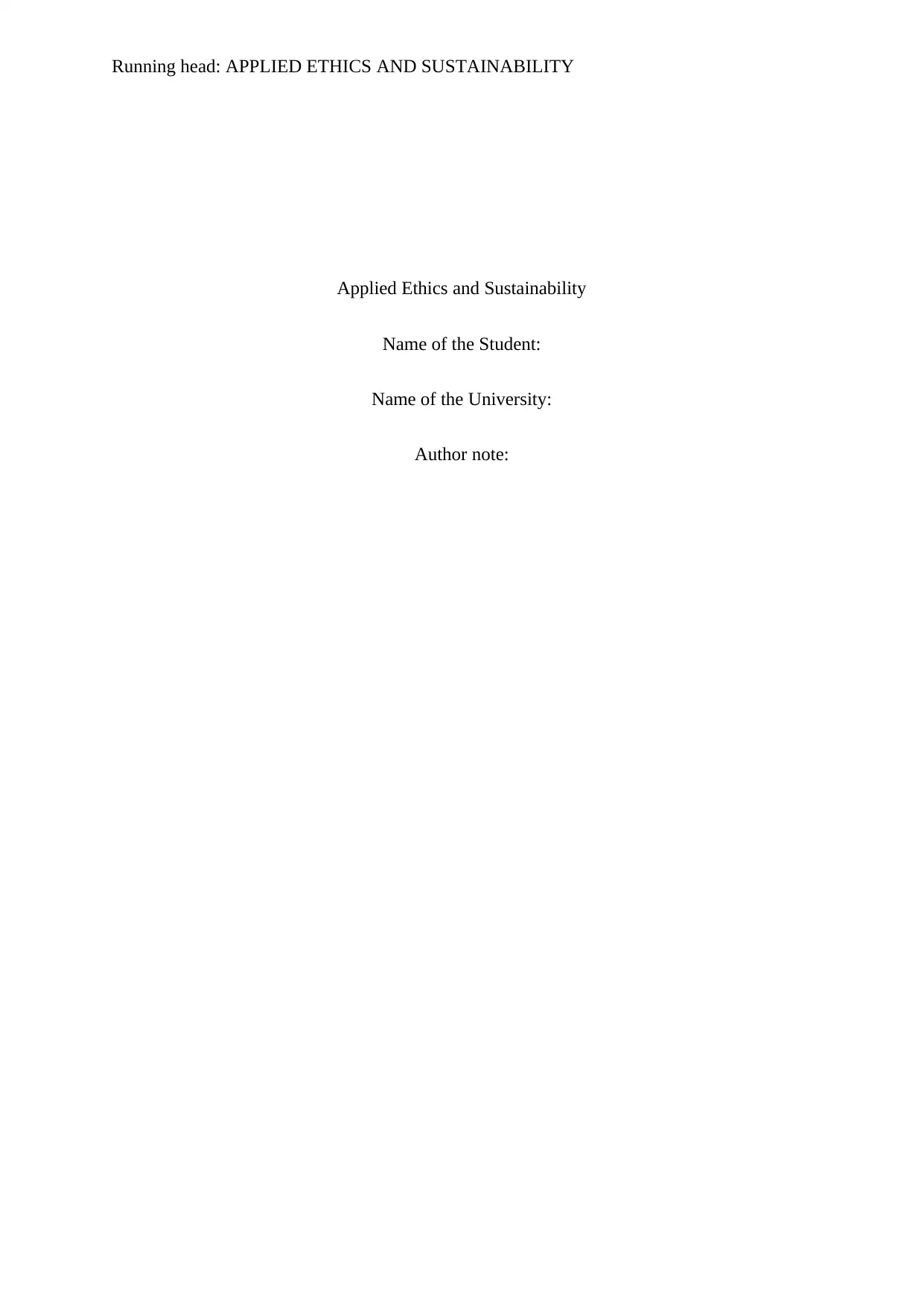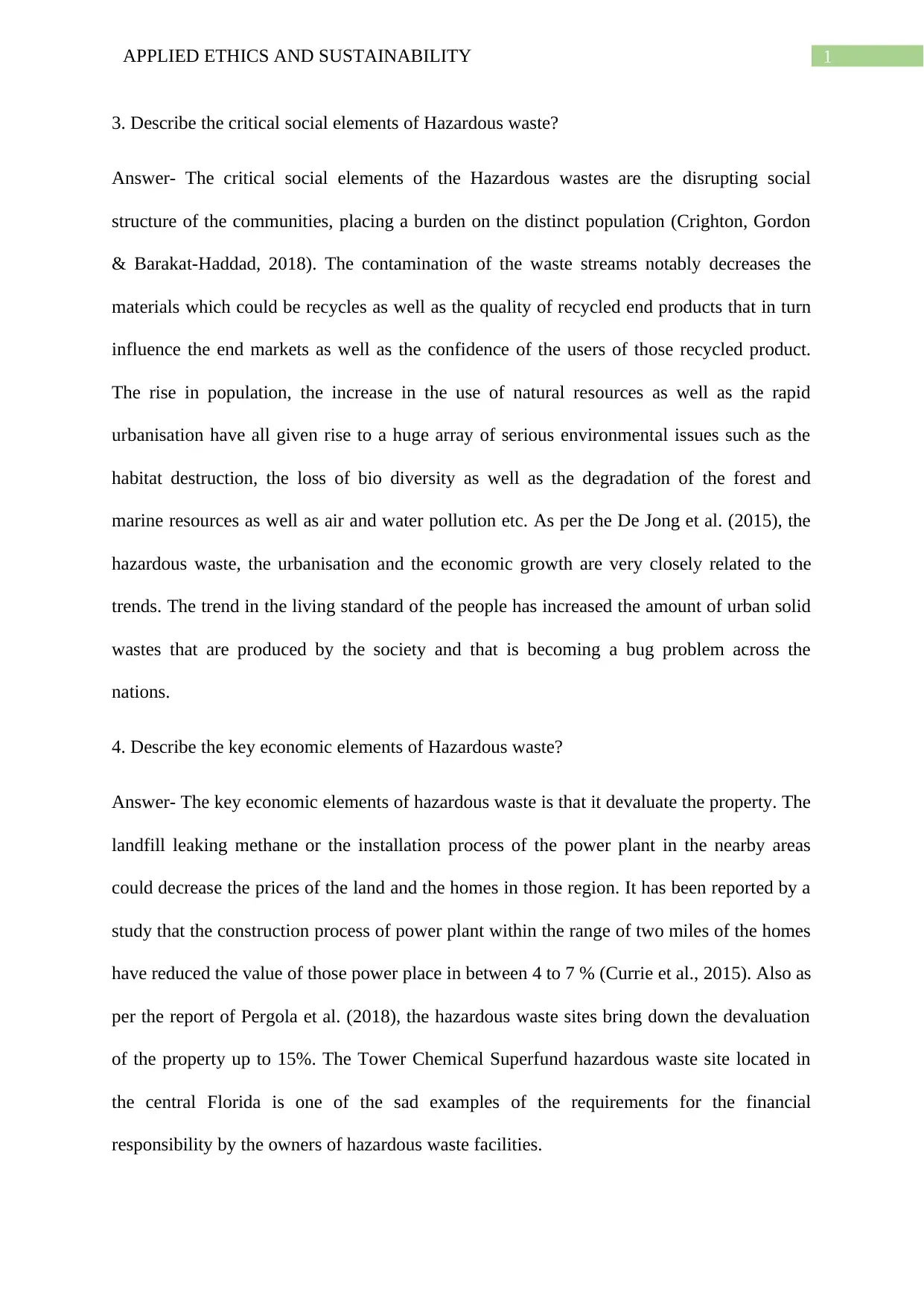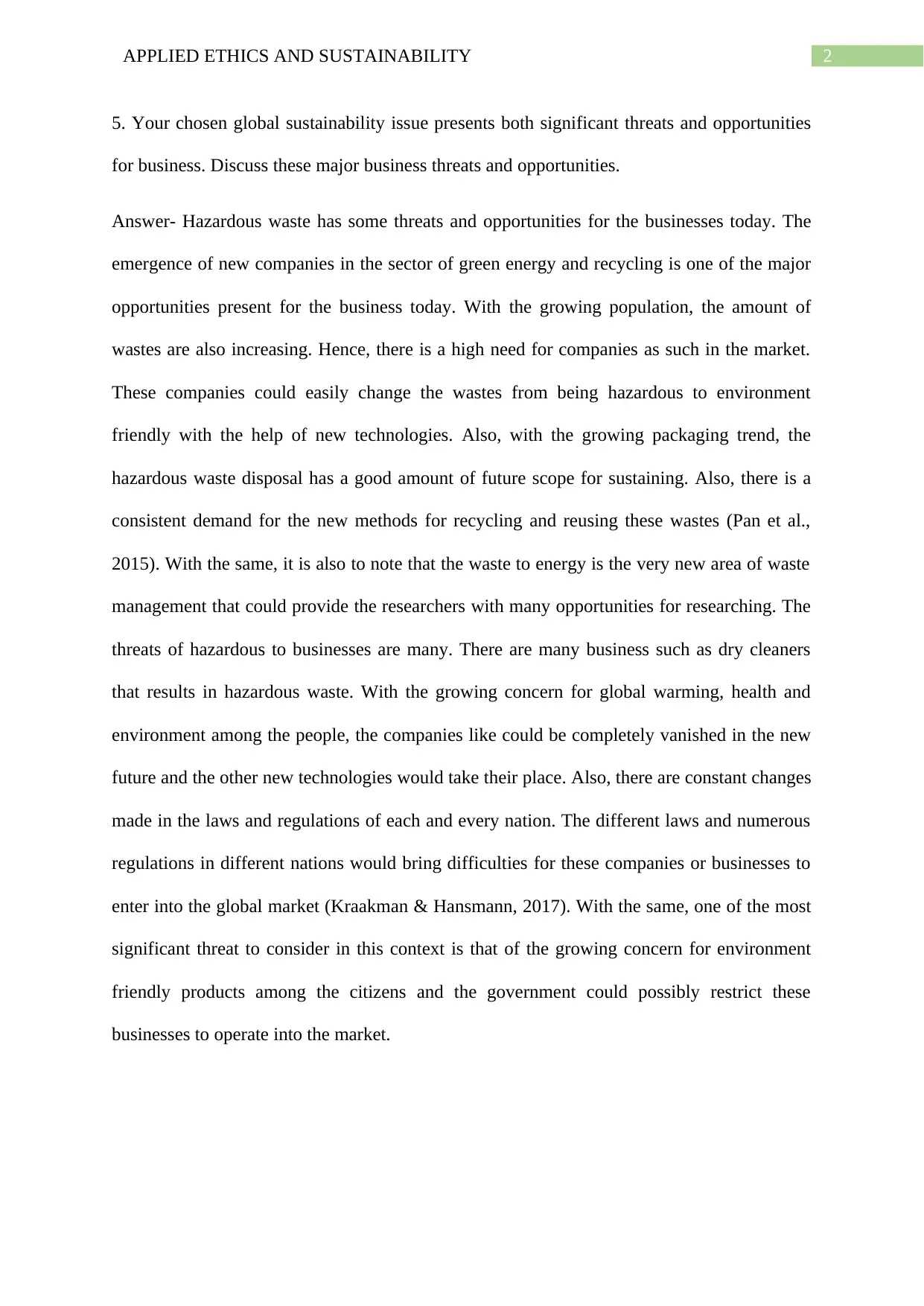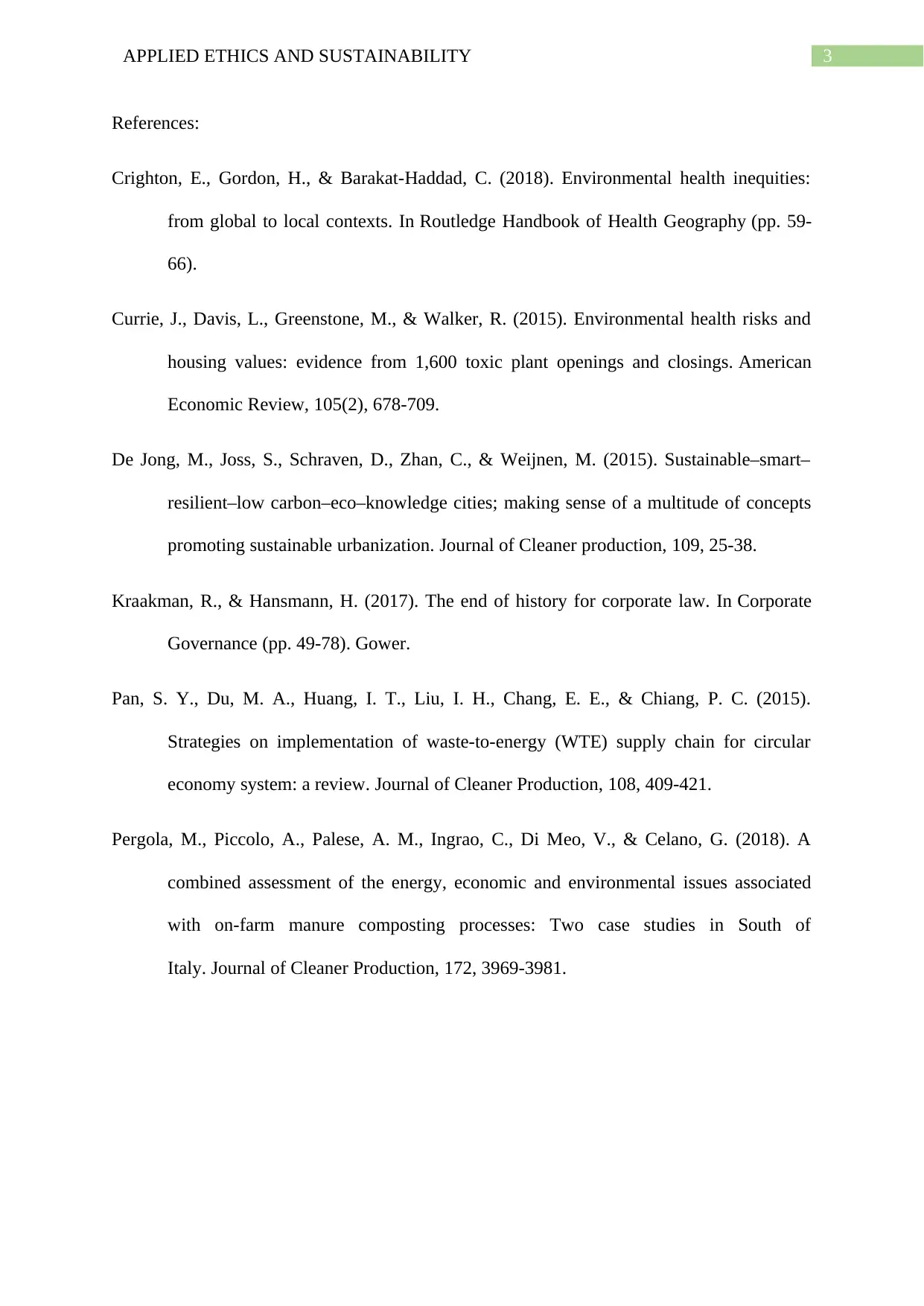SOC10236 - Hazardous Waste: Applied Ethics and Global Sustainability
VerifiedAdded on 2023/06/10
|4
|1052
|117
Essay
AI Summary
This essay provides an analysis of hazardous waste, examining its critical social and economic elements, as well as the threats and opportunities it presents for businesses. It discusses how hazardous waste disrupts social structures, burdens specific populations, and decreases the quality of recyclable materials. Economically, it highlights the devaluation of property near hazardous waste sites. The essay also explores the business opportunities in green energy and recycling, while acknowledging the threats posed by changing regulations and increasing environmental concerns. References to academic sources support the arguments presented, providing a comprehensive overview of the ethical and sustainability issues associated with hazardous waste.

Running head: APPLIED ETHICS AND SUSTAINABILITY
Applied Ethics and Sustainability
Name of the Student:
Name of the University:
Author note:
Applied Ethics and Sustainability
Name of the Student:
Name of the University:
Author note:
Paraphrase This Document
Need a fresh take? Get an instant paraphrase of this document with our AI Paraphraser

1APPLIED ETHICS AND SUSTAINABILITY
3. Describe the critical social elements of Hazardous waste?
Answer- The critical social elements of the Hazardous wastes are the disrupting social
structure of the communities, placing a burden on the distinct population (Crighton, Gordon
& Barakat-Haddad, 2018). The contamination of the waste streams notably decreases the
materials which could be recycles as well as the quality of recycled end products that in turn
influence the end markets as well as the confidence of the users of those recycled product.
The rise in population, the increase in the use of natural resources as well as the rapid
urbanisation have all given rise to a huge array of serious environmental issues such as the
habitat destruction, the loss of bio diversity as well as the degradation of the forest and
marine resources as well as air and water pollution etc. As per the De Jong et al. (2015), the
hazardous waste, the urbanisation and the economic growth are very closely related to the
trends. The trend in the living standard of the people has increased the amount of urban solid
wastes that are produced by the society and that is becoming a bug problem across the
nations.
4. Describe the key economic elements of Hazardous waste?
Answer- The key economic elements of hazardous waste is that it devaluate the property. The
landfill leaking methane or the installation process of the power plant in the nearby areas
could decrease the prices of the land and the homes in those region. It has been reported by a
study that the construction process of power plant within the range of two miles of the homes
have reduced the value of those power place in between 4 to 7 % (Currie et al., 2015). Also as
per the report of Pergola et al. (2018), the hazardous waste sites bring down the devaluation
of the property up to 15%. The Tower Chemical Superfund hazardous waste site located in
the central Florida is one of the sad examples of the requirements for the financial
responsibility by the owners of hazardous waste facilities.
3. Describe the critical social elements of Hazardous waste?
Answer- The critical social elements of the Hazardous wastes are the disrupting social
structure of the communities, placing a burden on the distinct population (Crighton, Gordon
& Barakat-Haddad, 2018). The contamination of the waste streams notably decreases the
materials which could be recycles as well as the quality of recycled end products that in turn
influence the end markets as well as the confidence of the users of those recycled product.
The rise in population, the increase in the use of natural resources as well as the rapid
urbanisation have all given rise to a huge array of serious environmental issues such as the
habitat destruction, the loss of bio diversity as well as the degradation of the forest and
marine resources as well as air and water pollution etc. As per the De Jong et al. (2015), the
hazardous waste, the urbanisation and the economic growth are very closely related to the
trends. The trend in the living standard of the people has increased the amount of urban solid
wastes that are produced by the society and that is becoming a bug problem across the
nations.
4. Describe the key economic elements of Hazardous waste?
Answer- The key economic elements of hazardous waste is that it devaluate the property. The
landfill leaking methane or the installation process of the power plant in the nearby areas
could decrease the prices of the land and the homes in those region. It has been reported by a
study that the construction process of power plant within the range of two miles of the homes
have reduced the value of those power place in between 4 to 7 % (Currie et al., 2015). Also as
per the report of Pergola et al. (2018), the hazardous waste sites bring down the devaluation
of the property up to 15%. The Tower Chemical Superfund hazardous waste site located in
the central Florida is one of the sad examples of the requirements for the financial
responsibility by the owners of hazardous waste facilities.

2APPLIED ETHICS AND SUSTAINABILITY
5. Your chosen global sustainability issue presents both significant threats and opportunities
for business. Discuss these major business threats and opportunities.
Answer- Hazardous waste has some threats and opportunities for the businesses today. The
emergence of new companies in the sector of green energy and recycling is one of the major
opportunities present for the business today. With the growing population, the amount of
wastes are also increasing. Hence, there is a high need for companies as such in the market.
These companies could easily change the wastes from being hazardous to environment
friendly with the help of new technologies. Also, with the growing packaging trend, the
hazardous waste disposal has a good amount of future scope for sustaining. Also, there is a
consistent demand for the new methods for recycling and reusing these wastes (Pan et al.,
2015). With the same, it is also to note that the waste to energy is the very new area of waste
management that could provide the researchers with many opportunities for researching. The
threats of hazardous to businesses are many. There are many business such as dry cleaners
that results in hazardous waste. With the growing concern for global warming, health and
environment among the people, the companies like could be completely vanished in the new
future and the other new technologies would take their place. Also, there are constant changes
made in the laws and regulations of each and every nation. The different laws and numerous
regulations in different nations would bring difficulties for these companies or businesses to
enter into the global market (Kraakman & Hansmann, 2017). With the same, one of the most
significant threat to consider in this context is that of the growing concern for environment
friendly products among the citizens and the government could possibly restrict these
businesses to operate into the market.
5. Your chosen global sustainability issue presents both significant threats and opportunities
for business. Discuss these major business threats and opportunities.
Answer- Hazardous waste has some threats and opportunities for the businesses today. The
emergence of new companies in the sector of green energy and recycling is one of the major
opportunities present for the business today. With the growing population, the amount of
wastes are also increasing. Hence, there is a high need for companies as such in the market.
These companies could easily change the wastes from being hazardous to environment
friendly with the help of new technologies. Also, with the growing packaging trend, the
hazardous waste disposal has a good amount of future scope for sustaining. Also, there is a
consistent demand for the new methods for recycling and reusing these wastes (Pan et al.,
2015). With the same, it is also to note that the waste to energy is the very new area of waste
management that could provide the researchers with many opportunities for researching. The
threats of hazardous to businesses are many. There are many business such as dry cleaners
that results in hazardous waste. With the growing concern for global warming, health and
environment among the people, the companies like could be completely vanished in the new
future and the other new technologies would take their place. Also, there are constant changes
made in the laws and regulations of each and every nation. The different laws and numerous
regulations in different nations would bring difficulties for these companies or businesses to
enter into the global market (Kraakman & Hansmann, 2017). With the same, one of the most
significant threat to consider in this context is that of the growing concern for environment
friendly products among the citizens and the government could possibly restrict these
businesses to operate into the market.
⊘ This is a preview!⊘
Do you want full access?
Subscribe today to unlock all pages.

Trusted by 1+ million students worldwide

3APPLIED ETHICS AND SUSTAINABILITY
References:
Crighton, E., Gordon, H., & Barakat-Haddad, C. (2018). Environmental health inequities:
from global to local contexts. In Routledge Handbook of Health Geography (pp. 59-
66).
Currie, J., Davis, L., Greenstone, M., & Walker, R. (2015). Environmental health risks and
housing values: evidence from 1,600 toxic plant openings and closings. American
Economic Review, 105(2), 678-709.
De Jong, M., Joss, S., Schraven, D., Zhan, C., & Weijnen, M. (2015). Sustainable–smart–
resilient–low carbon–eco–knowledge cities; making sense of a multitude of concepts
promoting sustainable urbanization. Journal of Cleaner production, 109, 25-38.
Kraakman, R., & Hansmann, H. (2017). The end of history for corporate law. In Corporate
Governance (pp. 49-78). Gower.
Pan, S. Y., Du, M. A., Huang, I. T., Liu, I. H., Chang, E. E., & Chiang, P. C. (2015).
Strategies on implementation of waste-to-energy (WTE) supply chain for circular
economy system: a review. Journal of Cleaner Production, 108, 409-421.
Pergola, M., Piccolo, A., Palese, A. M., Ingrao, C., Di Meo, V., & Celano, G. (2018). A
combined assessment of the energy, economic and environmental issues associated
with on-farm manure composting processes: Two case studies in South of
Italy. Journal of Cleaner Production, 172, 3969-3981.
References:
Crighton, E., Gordon, H., & Barakat-Haddad, C. (2018). Environmental health inequities:
from global to local contexts. In Routledge Handbook of Health Geography (pp. 59-
66).
Currie, J., Davis, L., Greenstone, M., & Walker, R. (2015). Environmental health risks and
housing values: evidence from 1,600 toxic plant openings and closings. American
Economic Review, 105(2), 678-709.
De Jong, M., Joss, S., Schraven, D., Zhan, C., & Weijnen, M. (2015). Sustainable–smart–
resilient–low carbon–eco–knowledge cities; making sense of a multitude of concepts
promoting sustainable urbanization. Journal of Cleaner production, 109, 25-38.
Kraakman, R., & Hansmann, H. (2017). The end of history for corporate law. In Corporate
Governance (pp. 49-78). Gower.
Pan, S. Y., Du, M. A., Huang, I. T., Liu, I. H., Chang, E. E., & Chiang, P. C. (2015).
Strategies on implementation of waste-to-energy (WTE) supply chain for circular
economy system: a review. Journal of Cleaner Production, 108, 409-421.
Pergola, M., Piccolo, A., Palese, A. M., Ingrao, C., Di Meo, V., & Celano, G. (2018). A
combined assessment of the energy, economic and environmental issues associated
with on-farm manure composting processes: Two case studies in South of
Italy. Journal of Cleaner Production, 172, 3969-3981.
1 out of 4
Your All-in-One AI-Powered Toolkit for Academic Success.
+13062052269
info@desklib.com
Available 24*7 on WhatsApp / Email
![[object Object]](/_next/static/media/star-bottom.7253800d.svg)
Unlock your academic potential
Copyright © 2020–2025 A2Z Services. All Rights Reserved. Developed and managed by ZUCOL.